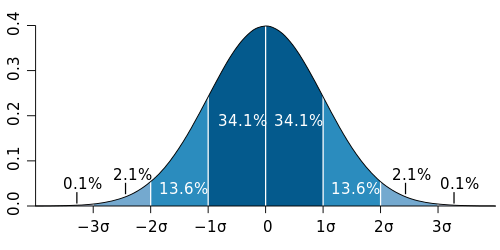Probability distribution

Probability distribution is a term from mathematics. Suppose there are many events with random outcomes. A probability distribution is the theoretical counterpart to the frequency distribution. A frequency distribution simply shows how many times a certain event occurred. A probability distribution says how many times it should have occurred in the long run (that is, its probability). The probability distribution of a random variable [math]\displaystyle{ X }[/math] is often written as [math]\displaystyle{ f_X(x) }[/math] (or simply [math]\displaystyle{ f(x) }[/math]).[1][2] Such a distribution can either be discrete, taking a discrete (or countable) amount of values, or continuous, taking an uncountable amount of values (as from a continuous interval).[3]
As an example, the probability distribution for a single roll of a normal 6-sided dice can be presented by:
| Result | [math]\displaystyle{ 1 }[/math] | [math]\displaystyle{ 2 }[/math] | [math]\displaystyle{ 3 }[/math] | [math]\displaystyle{ 4 }[/math] | [math]\displaystyle{ 5 }[/math] | [math]\displaystyle{ 6 }[/math] |
|---|---|---|---|---|---|---|
| Probability of result | [math]\displaystyle{ \frac {1}{6} }[/math] | [math]\displaystyle{ \frac {1}{6} }[/math] | [math]\displaystyle{ \frac {1}{6} }[/math] | [math]\displaystyle{ \frac {1}{6} }[/math] | [math]\displaystyle{ \frac {1}{6} }[/math] | [math]\displaystyle{ \frac {1}{6} }[/math] |
where result is the outcome of the dice roll, and the probability shows the chances of that result occurring. If we roll a dice 60 times, then in the long run, we should expect to have each side appear 10 times on average.
There are different probability distributions.[4] Each of them has its use, its benefits and its drawbacks. Some common probability distributions include:
Probability Distribution Media
The probability mass function (pmf) p(S) specifies the probability distribution for the sum S of counts from two dice. For example, the figure shows that p(11) = 2/36 = 1/18. The pmf allows the computation of probabilities of events such as P(X > 9) = 1/12 + 1/18 + 1/36 = 1/6, and all other probabilities in the distribution.
The probability mass function of a discrete probability distribution. The probabilities of the singletons {1}, {3}, and {7} are respectively 0.2, 0.5, 0.3. A set not containing any of these points has probability zero.
The cdf of a discrete probability distribution, ...
One solution for the Rabinovich–Fabrikant equations. What is the probability of observing a state on a certain place of the support (i.e., the red subset)?
Related pages
References
- ↑ "List of Probability and Statistics Symbols". Math Vault. 2020-04-26. Retrieved 2020-09-11.
- ↑ Bourne, Murray. "11. Probability Distributions - Concepts". www.intmath.com. Retrieved 2020-09-11.
- ↑ "1.3.6.1. What is a Probability Distribution". www.itl.nist.gov. Retrieved 2020-09-11.
- ↑ "Normal Distribution - easily explained! | Data Basecamp". 2021-11-26. Retrieved 2023-05-29.






